Solar Installers Rancho Santa Margarita
Best Solar Energy Companies in Rancho Santa Margarita
Get up to 3 Solar Energy Company quotes for your project today! Compare profiles, reviews, accreditations, portfolio, etc... and choose the best service.
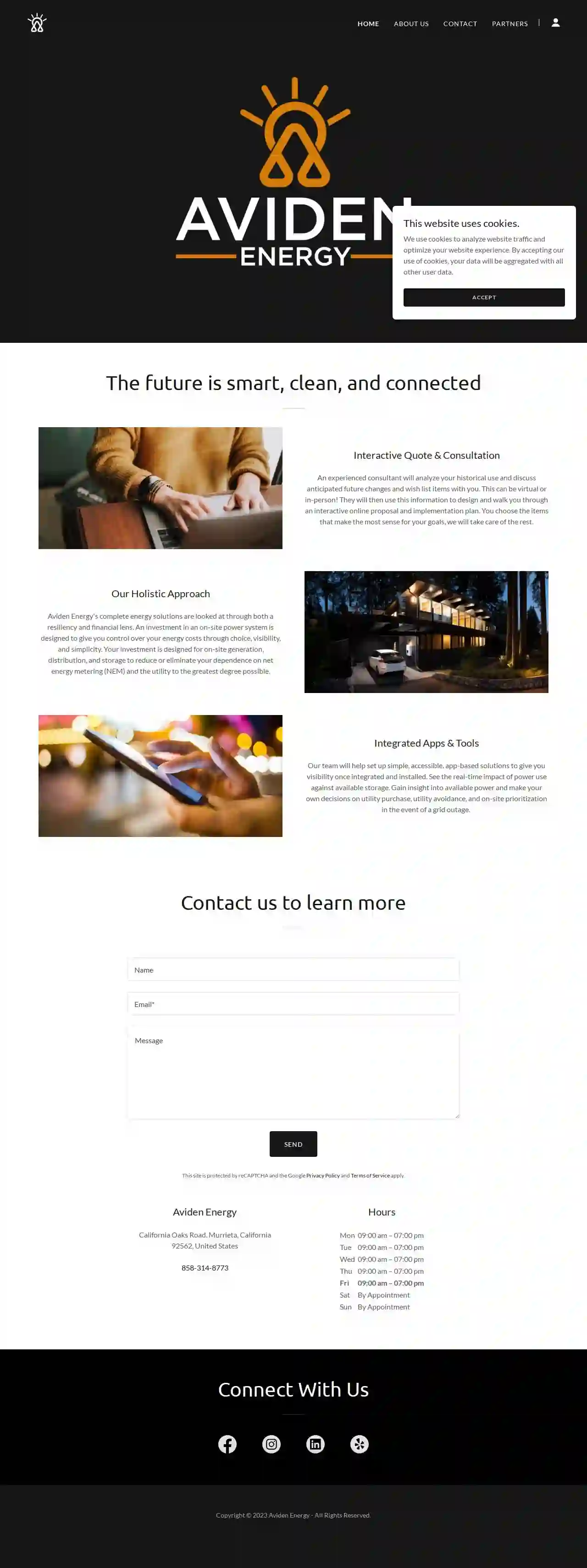
Aviden Energy
California Oaks Road, Murrieta, California 92562, 92562, USAviden Energy is a company that aims to provide a future where power is predictable, accessible, and honest. They offer comprehensive energy solutions that are designed to give customers control over their energy costs through choice, visibility, and simplicity. Their team has over a decade of industry experience in residential and commercial solar, and they pride themselves on the training and development of their employees, the experience of their partners, the accuracy of their projections, and the quality of the team's delivery.
- Services
- Why Us?
- Gallery
Get Quote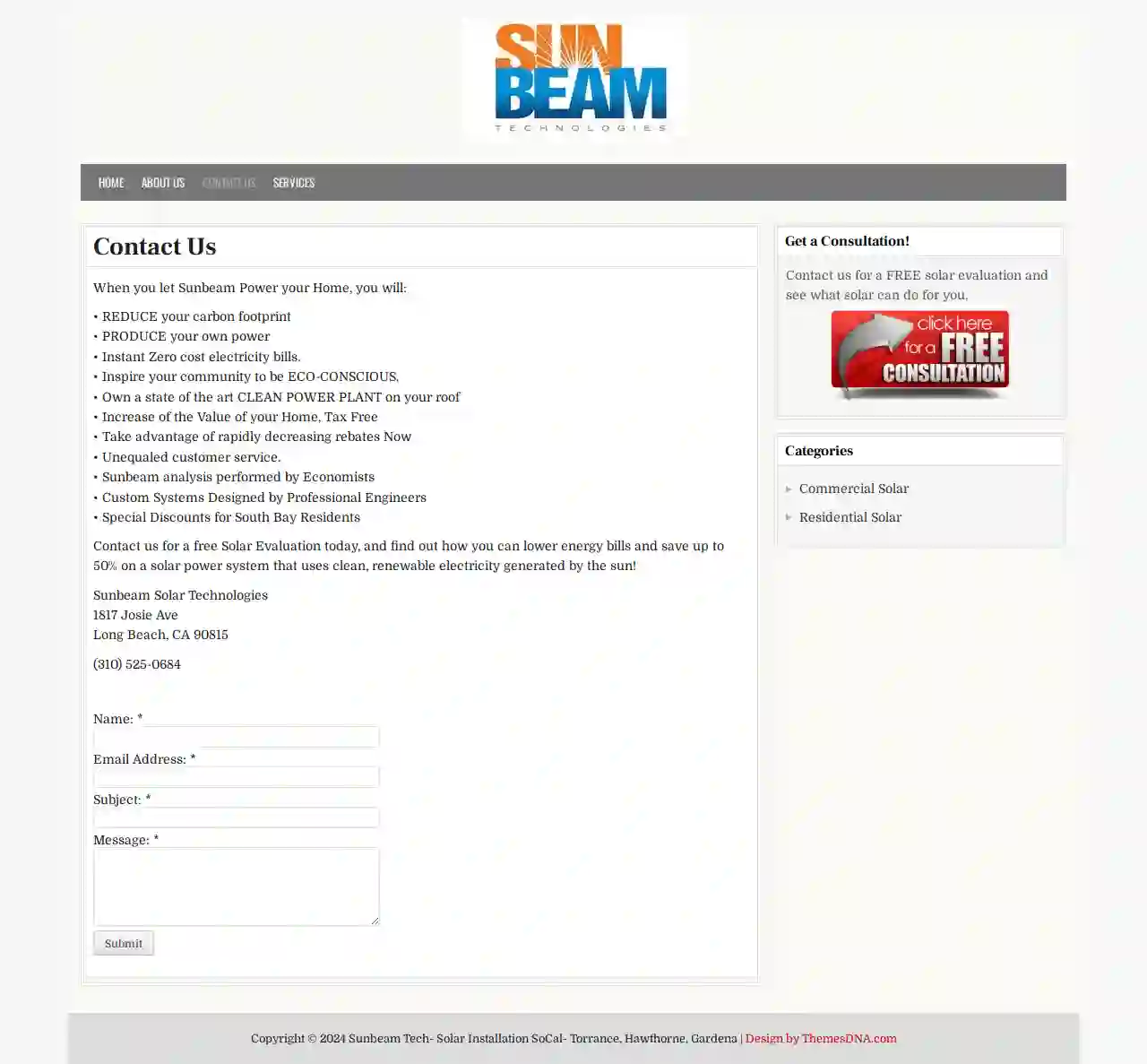
Sunbeam Solar Technologies
1817 Josie Ave, Long Beach, CA 90815, 90815, USSunbeam Technologies is a solar power solutions provider that offers clean, renewable electricity generated by the sun. They provide solar power systems for both businesses and homeowners, with a focus on providing high-quality and value. Sunbeam Technologies aims to help people reduce their carbon footprint, produce their own power, and inspire their community to be eco-conscious.
- Services
- Why Us?
- Accreditations
- Our Team
- Testimonials
- Gallery
Get Quote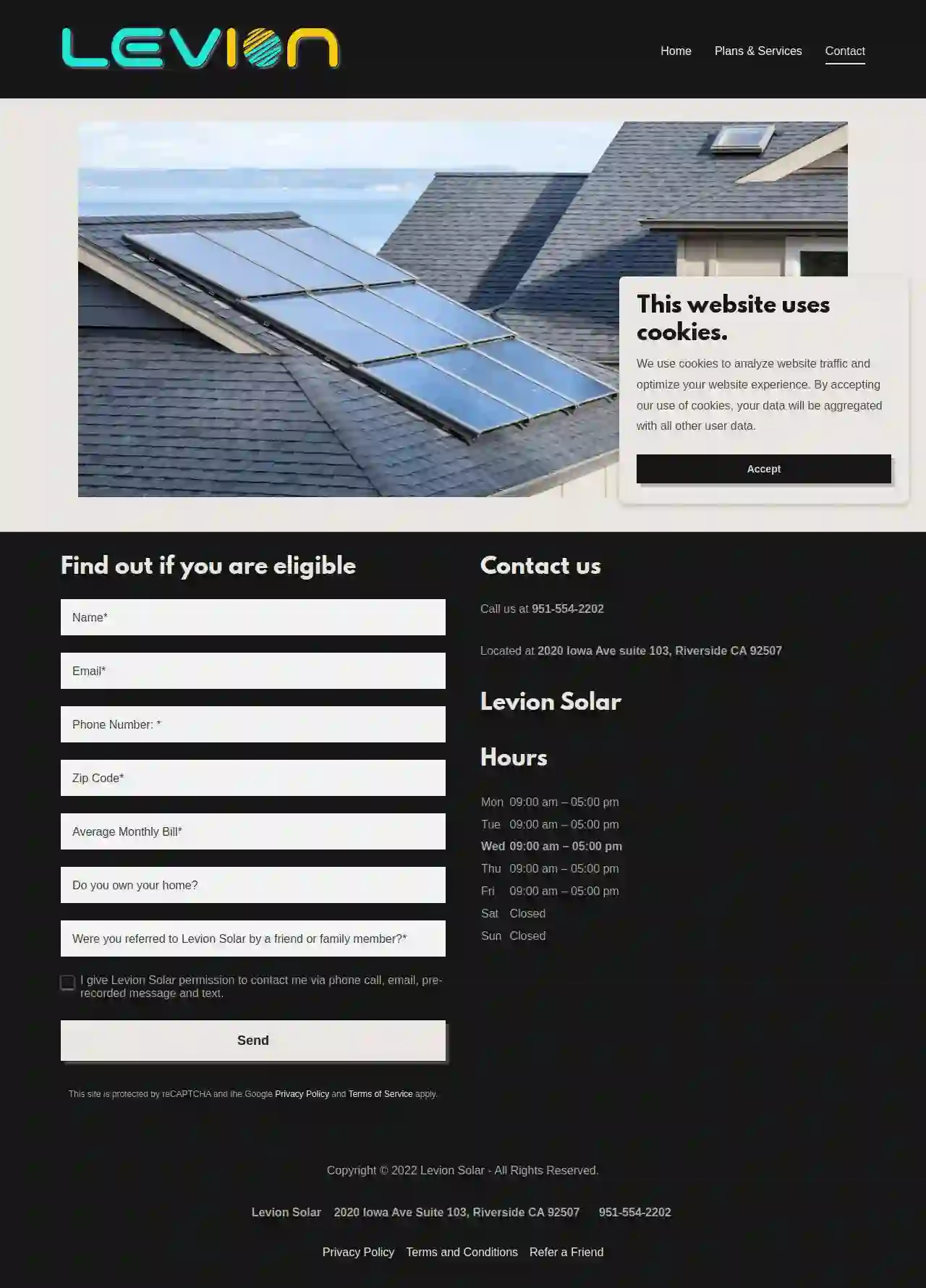
Levion Solar
2.845 reviews2020 Iowa Ave suite 103, N/A, Riverside, 92507, USLevion Solar is a company that specializes in providing sustainable and reliable energy solutions for homes. They offer customized solar power systems designed to meet the unique needs of each home. Their team of solar integrators guide customers through every step of the process, from assessment to installation. Levion Solar uses high-quality solar panels and premium inverters that are guaranteed to perform for 25 years. They also provide a 20-year warranty on workmanship. The company aims to help homeowners save money on their energy bills while also increasing the value of their homes.
- Services
- Why Us?
- Accreditations
- Our Team
- Testimonials
- Gallery
Get Quote
Canadian Solar Solutions
Guelph, Ontario, Canada, 545 Speedvale Avenue West, N1G 4K7, USCanadian Solar is a leading global provider of solar photovoltaic (PV) modules, solar power systems, and off-grid solar power application products. The company was founded in 2001 and has grown to become one of the world's largest solar power companies. Canadian Solar is dedicated to providing high-quality solar products, services, and solutions to meet the evolving clean energy requirements of its global corporate and utility customers. The company has a strong commitment to innovation, quality, reliability, and sustainability, and has been recognized for its achievements in these areas through numerous awards and certifications.
- Services
- Why Us?
- Accreditations
- Our Team
- Testimonials
- Gallery
Get Quote
SolarUp Inc.
4.819 reviews364 Supertest Rd #208, North York, ON, Toronto, M3J 2M2, USSolarUp is a leading solar panel installation and design company in Ontario, Canada. They offer a wide range of services including residential and commercial solar installations, solar projects, and a solar cost calculator. Their mission is to help Canadians save money and the environment through clean, affordable, and renewable energy solutions. They provide honest, expert advice, best-in-class warranty, and will beat any quote.
- Services
- Why Us?
- Accreditations
- Our Team
- Testimonials
- Gallery
Get Quote
Sun Image Solar
11 reviewsN/A, 819 2nd Street, Wasco, 93280, USSun Image Solar is a leading provider of clean and reliable solar installations. With over 100 years of combined experience and 5000+ solar installations, they offer a wide variety of solar panels for homes and businesses. Their team of well-trained sales specialists can help you become energy efficient with various financing options available.
- Services
- Why Us?
- Accreditations
- Our Team
- Testimonials
- Gallery
Get Quote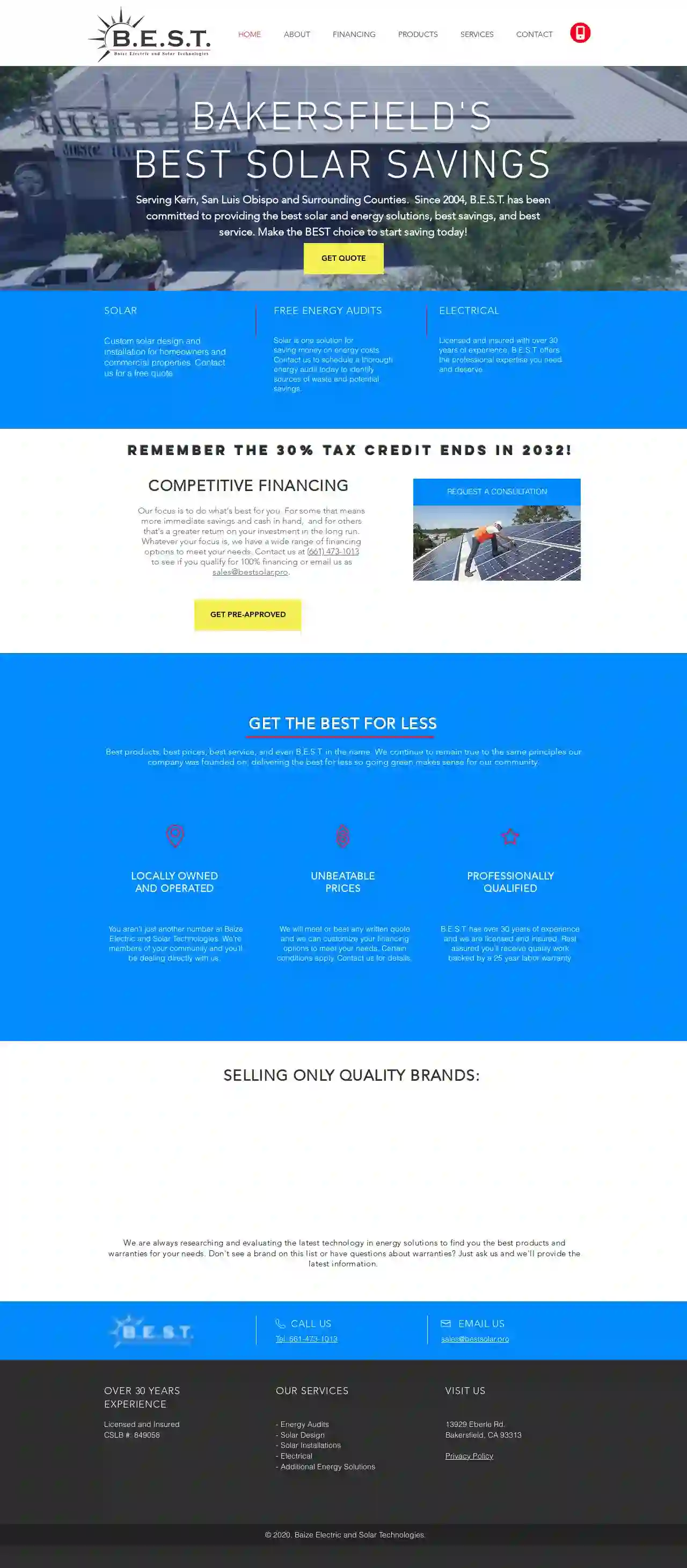
Best Solar
4.610 reviews13929 Eberle Rd, Bakersfield, 93313, USB.E.S.T. is a locally owned and operated business that has been providing the best solar and energy solutions, savings, and service since 2004. They offer custom solar design and installation for homeowners and commercial properties, free energy audits, electrical services, and competitive financing options. B.E.S.T. is committed to delivering the best for less, making going green a sensible choice for the community.
- Services
- Why Us?
- Accreditations
- Gallery
Get Quote
SunPower by Sun Solar
4.5193 reviewsActon, CA, Antelope Valley, 2210 Soledad Canyon Road, 93510, USSunPower by Sun Solar is a Bakersfield solar company that is committed to providing high-quality, efficient solutions to meet your residential and commercial energy needs. Our team is made up of seasoned professionals who provide personalized, top-notch service throughout each stage of the process, from initial consultation to design to installation. Plus, our solar panels are built with Maxeon® solar cell technology, ensuring efficiency and durability unmatched by standard panels. Our 25-year complete confidence warranty gives our customers peace of mind, and we are committed not only to helping you save money and reduce your carbon footprint but also to making your switch to solar energy as smooth and beneficial as possible.
- Services
- Why Us?
- Accreditations
- Gallery
Get Quote
Allesun solar
San Jose, California, 123 Solar Way, 95134, USAllesun was incorporated in May 2006, current headquarter in San Jose California USA and Vancouver Canada, one manufacturer each in Cambodia, Vietnam and USA. Specializing in manufacturing Solar Cell PERC&TOPCON Technology and Module. Current Capacities are 1GW solar cells and 1GW PV modules totally by Sole Invested. And we also have shared companies and with combined capacity of solar panels reaching up 5GW. The cells are manufactuer from Texturing, B/P Diffusion, Etching,LPCVD/RCA/ALD/PECVD/Sintering,Printing to IV Testing& Sorting and the traceability files could be provided as per request by customers. Quality is our first concern. All raw materials we purchased are from the suppliers of TOP5 in the world even at a higher cost, we believe it is the key and first step to keep high and stable quality. Currently we have obtained ETL/CSA(UL), DEKARA /IEC61215 /61730 /CEC and BIS for PV modules supervised under ISO9001:2015,ISO14001:2015.
- Services
- Why Us?
- Accreditations
- Our Team
- Testimonials
- Gallery
Get Quote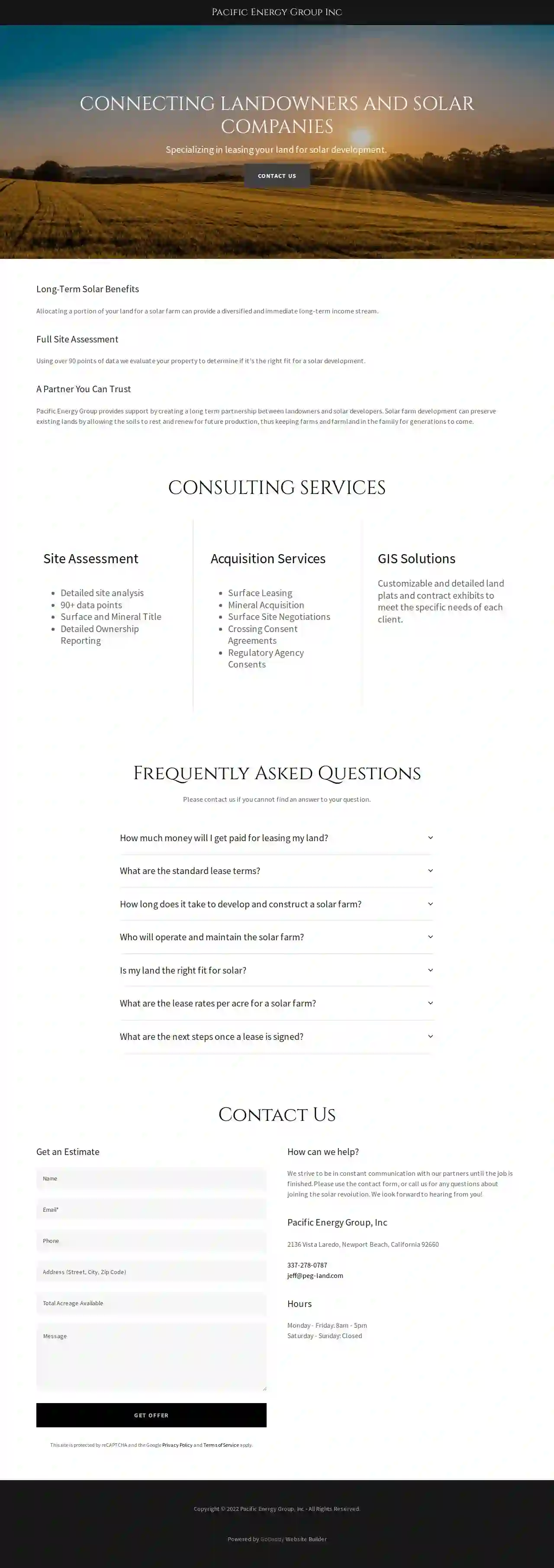
Pacific Energy Group, Inc.
2136 Vista Laredo, Newport Beach, 92660, USPacific Energy Group Inc specializes in leasing land for solar development, providing a diversified and immediate long-term income stream for landowners. They offer consulting services including site assessment, acquisition services, and GIS solutions. The company aims to create a long-term partnership between landowners and solar developers, preserving existing lands for future production.
- Services
- Why Us?
Get Quote
Over 4,210+ Solar Contractors on our directory
Our solar providers operate in Rancho Santa Margarita & surroundings!
SolarCompaniesHub has curated and vetted Top Solar Installers near Rancho Santa Margarita. Find the most trustworthy business today.
Frequently Asked Questions About Solar Installers
- Adequate Sunlight: Unobstructed sunlight for a significant portion of the day.
- Sufficient Space: Enough space to accommodate the desired number of panels.
- Structural Integrity: A strong roof structure capable of supporting the weight of the panels.
- Appropriate Orientation and Tilt: Ideally, the roof should face south (in the Northern Hemisphere) or north (in the Southern Hemisphere) with a tilt angle close to the latitude of your location. However, other orientations and tilts can still be effective.
- Keep Panels Clean: Clean panels periodically to remove dirt, debris, and bird droppings, which can reduce efficiency. Rainfall usually cleans panels adequately, but you might need to hose them down occasionally.
- Visual Inspections: Regularly inspect panels for signs of damage, loose wiring, or other issues.
- Professional Maintenance: Consider having a professional solar installer inspect your system every few years to ensure optimal performance.
What is net metering, and how does it work?
How do I know if my roof is suitable for solar panels?
Do solar panels increase my home value?
How do I maintain my solar panels?
What is net metering, and how does it work?
How do I know if my roof is suitable for solar panels?
- Adequate Sunlight: Unobstructed sunlight for a significant portion of the day.
- Sufficient Space: Enough space to accommodate the desired number of panels.
- Structural Integrity: A strong roof structure capable of supporting the weight of the panels.
- Appropriate Orientation and Tilt: Ideally, the roof should face south (in the Northern Hemisphere) or north (in the Southern Hemisphere) with a tilt angle close to the latitude of your location. However, other orientations and tilts can still be effective.
Do solar panels increase my home value?
How do I maintain my solar panels?
- Keep Panels Clean: Clean panels periodically to remove dirt, debris, and bird droppings, which can reduce efficiency. Rainfall usually cleans panels adequately, but you might need to hose them down occasionally.
- Visual Inspections: Regularly inspect panels for signs of damage, loose wiring, or other issues.
- Professional Maintenance: Consider having a professional solar installer inspect your system every few years to ensure optimal performance.